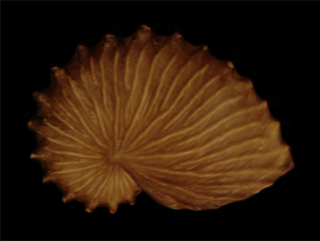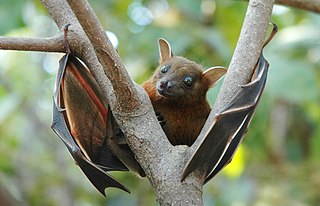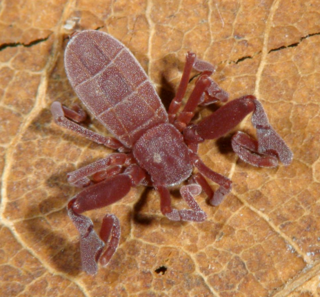
Argonauta bottgeri, also known as Böttger's argonaut, is a species of pelagic octopus belonging to the genus Argonauta. The female of the species, like all argonauts, creates a paper-thin eggcase that coils around the octopus much like the way a nautilus lives in its shell.

The genus Scarabaeus consists of a number of Afro-Eurasian dung beetle species, including the "sacred scarab beetle", Scarabaeus sacer and is the namesake of the tribe Scarabaeini, the family Scarabaeidae, the superfamily Scarabaeoidea and the infraorder Scarabaeiformia. These beetles feed exclusively on dung, which they accomplish by rolling a piece of dung some distance from where it was deposited, and burying it in order to feed on it underground. They also prepare food for their larvae by excavating an underground chamber, and filling it with balls that have eggs laid in them. The growing larva feeds upon the dung ball, pupates, and eventually emerges as an adult.

The greater musky fruit bat is a species of megabat in the family Pteropodidae. It is endemic to the Philippines. It was named by Peters for Fedor Jagor.

Georissa is a genus of minute land snails, terrestrial gastropod mollusks in the family Hydrocenidae. Although the species are best known for living on the surface of limestone rocks, they are often also found in and on the vegetation and on non-calcareous rocks. One species, Georissa filiasaulae, is cavernicolous. It is only known from two caves in the Sepulut area of Sabah, Malaysian Borneo, where its above-ground sister species, Georissa saulae, inhabits the rocks outside of the cave, and is connected to the cave snail via narrow zones of hybridization at the cave entrances. Possibly, G. filiasaulae has evolved without ever having been fully separated from its ancestor, a process known as speciation-with-gene-flow.

The lesser short-nosed fruit bat is a species of megabat within the family Pteropodidae. It is a small bat that lives in South Asia and Southeast Asia. It weighs between 21 and 32 grams, and measures 70 to 127 millimetres. It occurs in many types of habitat, but most frequently in disturbed forest, including lower montane forest and tropical lowland rain forest, plus gardens, mangroves, and vegetation on beaches.

The family Cavoliniidae is a taxonomic group of small floating sea snails, pelagic marine opisthobranch gastropod mollusks.

The helmet toktokkies are ground-dwelling, Afrotropical beetles in the family Tenebrionidae.
Henning Mourier Lemche was a Danish zoologist.

Pseudocellus is an arachnid genus in the order Ricinulei, first described by Norman Platnick in 1980. It is native to the Neotropics.

Labidostomis is a genus of short-horned leaf beetles belonging to the family Chrysomelidae, subfamily Cryptocephalinae.

Ophryotrocha is a genus of marine polychaete worms in the family Dorvilleidae.

Cavolinia globulosa is a species of gastropod in the family Cavoliniidae.
Cavolinia labiata is a species of pteropod in the family Cavoliniidae. It is a tropical species occurring in the Western Atlantic and Eastern Pacific Oceans. It can reach 0.7 cm (0.28 in) in length.

Cavolinia uncinata is a species of gastropod in the family Cavoliniidae.

Cavolinia is a genus of gastropods belonging to the family Cavoliniidae.
Pheromermis is a genus of nematodes belonging to the family Mermithidae.
Ethmostigmus pachysoma is a species of centipede in the Scolopendridae family. It is endemic to Australia and was first described in 1983 by L. E. Koch.













